
How to make a website is one of the first questions to be asked by every new webmaster. After all, the foundation used to build your site will dictate your online project’s flow and growth of your online project. So, it’s essential to make a solid plan and study every possible option. In this guide, we will cover how to create a website using a Content Management System called WordPress and an easy-to-use platform called Website Builder.
Each path is unique and has a set of pros and cons. That’s why we’re going to highlight the most important aspects of website building to make the decision-making process more manageable.
- ESTABLISH YOUR WEBSITE IDEA

First of all, you need to determine what will be the purpose of your website. There’s a lot of website ideas out there for taking. And they have the potential to make good money online with the right execution. Start by determining the primary objective and functionality you want to provide. Some of the most common types of websites include:
- eCommerce – Online shops are some of today’s most famous sites. As the popularity of shipping drops decreases, everyone has the opportunity to start an online side company. You can sell both digital and physical products to customers from all over the globe (which wouldn’t be as easy as a retail store).
- Blogs – Many successful webmasters began their journey with a simple query: how to start a blog. Blogging can be either a business (e.g., affiliate, review, niche blog) or a leisure-oriented activity (travel, food, music, books) covering a wide range of topics.
- Educational – Are you well-seasoned with a particular skill? Why not create digital courses or a website type membership. If you’re a fan of a specific hobby or skill, creating an educational site can help you establish yourself as a niche expert.
- News – In this age of online anarchy, it’s easier than ever to launch a news site. Every day, people look for information from all sources. If producing innovative news is what you’re aiming for, making a website easier will help you get your message across the globe.
- Online Communities – The sheer number of thriving online communities is a clear message that the most important thing is to get started. Since building broad audiences takes a lot of time, the faster you start – the better.
- Portfolios – Showing your skills and strengths can significantly improve your online presence and visibility. Also, online portfolios will give you an edge in work interviews, promotions and business deals.
Once you have a clear goal in mind, it will be easier to choose the right hosting and website building platform.
2. REGISTER A DOMAIN NAME

You’ll need to come up with a catchy name before you make a website. To get your site’s domain name, you should:
- Brainstorm potential website name ideas.
- Find a domain checker.
- Run a domain name search
- Pick the best options(s).
- Finalize your order and complete the domain registration
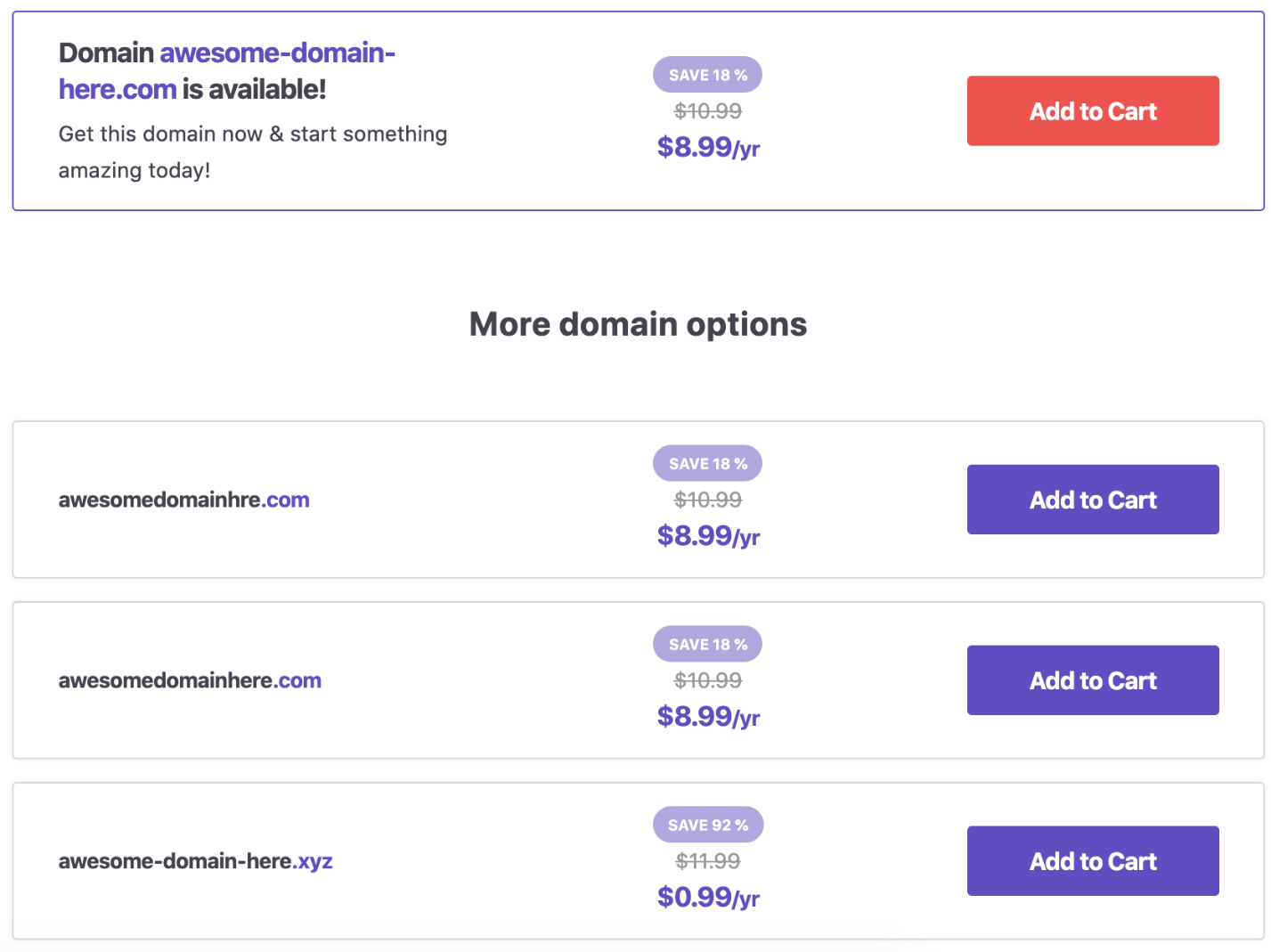
Finding the right name may be very difficult. Here are some great tips that will help you:
- Go for.com. Being the most popular TLD, the.com domain will be easier for your visitors to remember.
- Check out the close alternatives. Registration of mistyped and similar versions of your domain name will ensure that all traffic reaches your website.
- Only try to keep it short. The quicker and the catchier the domain name, the better. Long domain names can be challenging to recall.
- Avoid the numbers and the hyphens. Only do it if you really have to, because they will increase the risk that your address will be mistyped.
3. ACQUIRE WEB HOSTING
The next step in your journey of building your website is to choose a proper host. Although there are various types of web hosting out there, the one you need depends on how large your online project is. Hostinger provides three exclusive choices that fit all shapes and sizes of web pages. Let’s take a quick look at which hosting program is right for you.
SHARED HOSTING

Shared hosting is a form of server that houses multiple users, and is best suited for small and medium-sized websites. Think of it as public transport, like a bus or a train. All websites use one physical server with the same pool of resources. This unique setup permits affordable pricing but also comes with more stringent limitations. Primarily, it provides every passenger with a smooth ride and ensures that one user uses not too much power.
WHAT WILL YOU GET?
Shared hosting provides a range of resources to help you build a website, starting with:
- 1-Click Installer
- Access Manager
- FTP/File Managers
- Weekly Backups
- Cache Manager
- Free Domain Registration
- Powerful Control Panel
The shared hosting is generally a great start for any website or online project. If you don’t expect a lot of traffic at first, that solution is the perfect place to start.
CLOUD HOSTING

It aims to make shared hosting simple while delivering virtual server resources. This approach offers the highest possible uptime with the aid of cloud storage technology by maintaining a copy of your website on multiple servers that function together in harmony. The remaining servers in the cluster make sure that everything is up and running if one of the servers goes down.
WHAT WILL YOU GET?
Besides any hosting perk you share, you’ll also get:
- A Dedicated IP Address
- Isolated Resources
- A Free Lifetime SSL Certificate
- Cloudfare Integration
Businesses relying on the uptime of their website will reap the maximum benefits. If you expect large traffic spikes right off the bat, the way to go is cloud hosting. Apart from that, eCommerce stores, large-scale projects, news websites with lots of new and recurring visitors will find that the most appropriate is cloud hosting.
If you are looking for power without the technical struggle, the right pick is cloud hosting.
VPS HOSTING

Overall, out of all the options, VPS hosting provides the most customizations. Thanks to root access, everything from the operating system to the software stack will be inside your control.
WHAT WILL YOU GET?
- A Dedicated IP
- 1-Click OS Install
- Server Snapshots
- Isolated Resources
- The freedom to build your own environment
The servers are preconfigured with shared/cloud storage, so it would not be possible to change other aspects (such as the software stack). But VPS grants root access and full freedom to build your foundation. If you need a custom solution, then you should consider virtual servers.
4. PICK A PLATFORM AND BUILD YOUR WEBSITE

Now commences the real work. The process of creating your website will depend on the base you choose. Also, the idea you want to execute will play a part in the final decision.
HOW TO MAKE A WEBSITE WITH WORDPRESS

Holding the title as the most popular content management system, WordPress empowers its users to create a website of any type. While many people use it for blogging, using a wide range of customization features and plugins, you can make anything from an eCommerce store to a review website.
INSTALLATION
Installing WordPress with Hostinger is as simple as it can get. The latest version of the script is available under Auto Installer on the hpanel in the Website section.
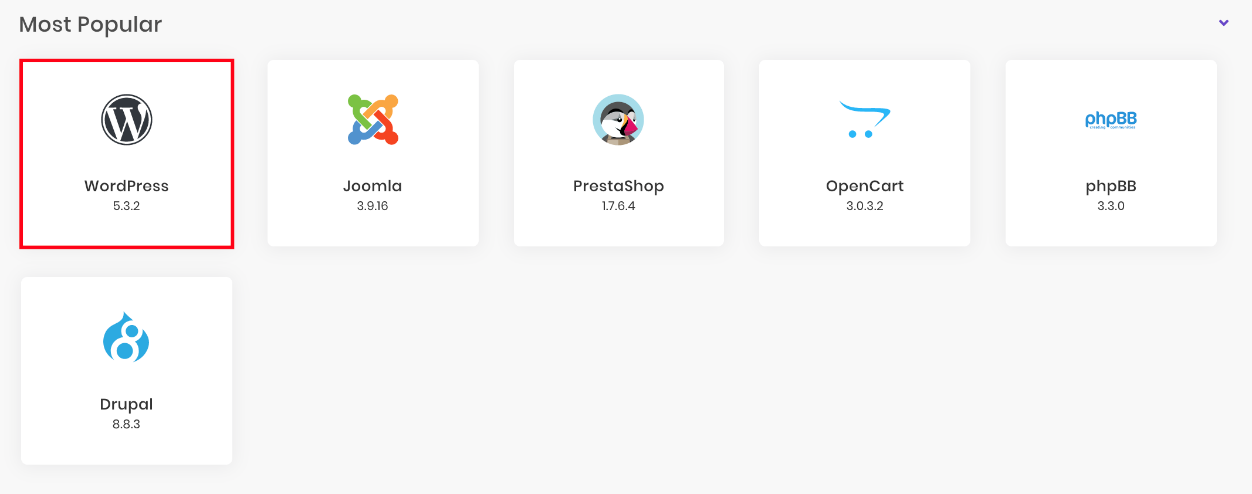
Enter the required details and, within minutes, your CMS will be ready for use.

Be aware during this process, as you will need to create your admin user and enter a few other basic settings.
ADMIN AREA

Navigate to yourdomain.com/wp-admin once the setup is done to find the WordPress Dashboard.To access it, fill in the credentials you mentioned during the setup process. Youcan manage anything relating to your WordPress website, content, and users inside this back-end screen.
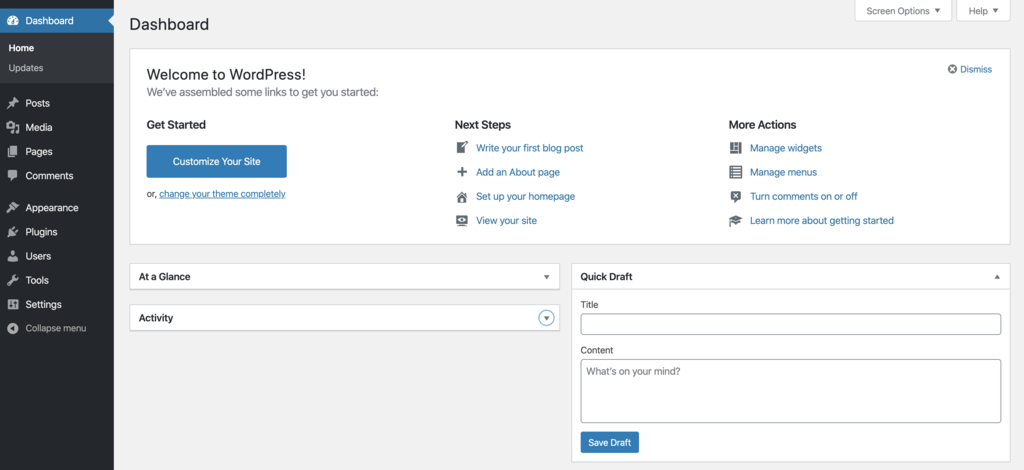
THEMES AND DESIGN
One of the main benefits of having a WordPress site is the vast variety of themes. Whatever it takes to design your idea, you will surely find it. The official repository for WordPress theme has over 7000 unique options. You can find all of them in the Dashboard ‘s Appearance > Themes section.
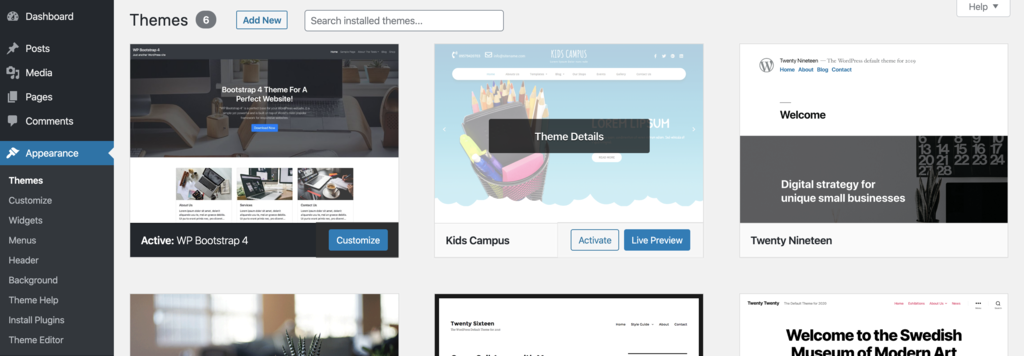
If you select the Add New button, you can preview and install all themes available in the WP theme repository. In case you wish to make changes, you can head over to the Appearance › Customize section.

Generally, it can be hard to pick the best concept out of 7000 contenders. Just look at our set of the best free WordPress themes to narrow down your choice.
CONTENT AND PAGES
WordPress essentially lets you upload and create three types of content:
- Pages – You can create static pages with this section, which don’t expect a lot of changes. For instance: Home, About Us, Contact, etc.

- Posts – A section where you can create dynamic content, such as articles, blog posts and guest publications.

- Media – Contains images, audio files, and videos. You will be able to attach those resources to your posts and pages after the upload.

PLUGINS AND EXTENSIONS
Another significant benefit of WordPress is the sheer number of plugins you can use to introduce new functions and features. You can start at the section Plugins, where you can select Add New to install new plugins. You can find all existing ones within the section on Installed Plugins.
HOW TO CREATE A WEBSITE WITH WEBSITE BUILDER

The website builder is a quick and easy to use way to design and publish a site when you’re not a developer. Everything from the themes to SEO and cart functionality can be controlled within a single dashboard. It also has a drag-and-drop feature that lets you build everything the way you want.
No additional setup is required to build a site. All you have to do is access the Website Builder tool in your control panel. Make sure all other scripts are backed up / removed prior to use. If you use a website builder to publish your site, this can override any of the existing files.
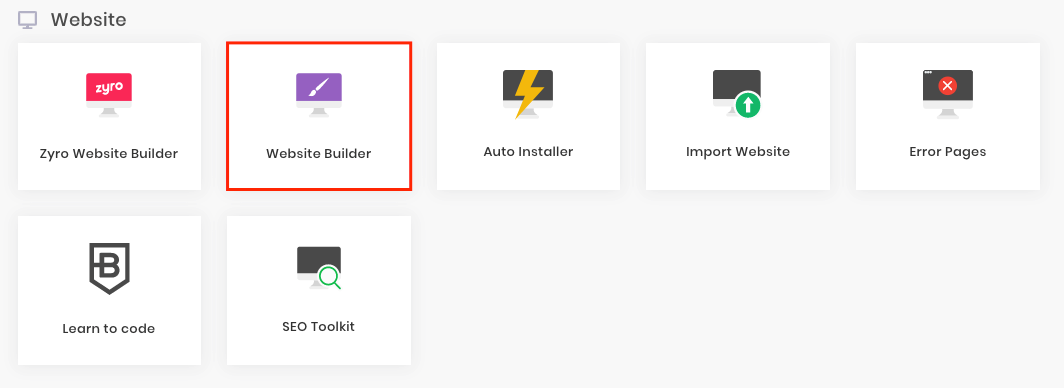
LAYOUT AND DESIGN
The first step is to choose a look. You can choose from around 200 free templates or import any website using the built-in migration tool.

There are categories for every type of site out there, depending on what you want to build from simple landing pages to hotels and e-commerce stores. Once you’ve found the perfect theme, you’ll be taken to the Web Builder interface.
TOOLS AND DEVELOPMENT PROCESS
Now the real fun is starting. You will see a menu with all the tools at your disposal in the upper section of your screen. Let’s see what the building features of the website are on the table.

First up, you’ll see some basic functions, such as:
- Publishing, saving, and back up tool
- Website preview feature
- Undo/redo buttons
- Resetting the current project
- Adjusting responsiveness based on the device

Then you will find a handful of advanced features that will help you design and structure your site, such as:
- Shopping cart functionality
- Various payment gateways
- Social media integration
- Location service via Google or Bing maps
- Adding videos via YouTube
- Tools to create buttons, blocks, and menus

Last but not least is the upper-right section. You can use it to control even more technical aspects, such as:
- Creating pages and navigation.
- Setting a language.
- SEO factors (such as meta titles, descriptions, keywords, permalinks, forcing HTTPS.)
- Site identity (favicon, background, style.)
If you’re doing a small/medium-sized project, it’s definitely worth a try. Plus, there are a lot of great website builders on the market. Most importantly, they can be used by anyone.
Congratulations to you! By finishing this guide, you’ve explored the different ways to make a website.
You’ve also learned a few growth tips and introduced yourself to several excellent tools that will make you stand out in the crowd. So, what are you waiting for?
